back to HTX-202 attenuator use
s-meter debate
s-meter debate:
R303 and R304 are the scalars for IC301-A for the RX meter
it may be the case that the AGC in ("SQL") doesn't have the necessary range to input, it may be maxing out
the squelch DOES work
confirmed, max squelch opens at -97.5dB, which is huuuuge. (what is that in uV?)
I need to attack the problem from the squelch circuit, not the s-meter
SQL goes to the SIDE of the squelch pot. center goes back to the audio chip
R35 just "ends", and may be a test or injection point
BUSY indicates opem squelch
IC4-14 is the source of busy?
MC3371DR2 is an audio single chip (FM) receiver
IC4-13 is the meter out from the chip. it claims a 60dB range, which would be a nice convenient 10 s-units
either the chip nowhere near meets specs for METER, or its input is being driven non-linearly by an earlier stage
need to check the voltage on the R35 test point, though I suspect it will range from 1.0 to 2.0 volts across s1-s9
https://www.n1fd.org/2023/04/11/interpreting-s-meter-readings/
claims VHF uses a different standard for S9, notably Ð93 dBm (5 uV) into a 50-ohm receiver input. A value of 6 dB
still represents 1 S-unit. So that'd put S1 at some insanely low signal level (0.02uV) that no normal ham radio
is ever going to get near, making it pretty improbable
The HTX-202 has a specified 12dB SINAD (minimum required signal for copying) of 0.2uV, which is pretty stamdard
amd is the rated "s1" signal level for meters (on HF anyway) 0.19uV if you wan to get technical (50/256)
terms:
dBv is a measure of volts:
dBm is a measure of power
-107dBm = 1 micro volt
-87dBm = 10 micro volt
-67dBm = 100 micro volt
-47dBm = 1 milli volt
adding 6dBm doubles the uV, adding 20dBm multiplies the uV by 10
adding 3dBm doubles the power, adding 10dBm multiplies the power by 10
HF: S9=50uV, S1=0.19uV (50/256)
VHF: S9=5uV, S1=0.019uV
so each s-unit is still 6dBm, HF or VHF

dBm to MicroVolts Conversion Chart (at repeater-builder.com)
dBm to MicroVolts Conversion Chart (for 50 ohm systems)

dbm-watt-conversion-tables.pdf

Interpreting S-Meter Readings (at N1FD)

s-meter-standard.pdf (391 KB)
dBm to Watt Conversion Table:

Negative dBm to Watt Conversion Table:

highest resolution images
last updated 10/29/2025 at 14:09:49 by make_www_index.command version 2025.06.28.A





